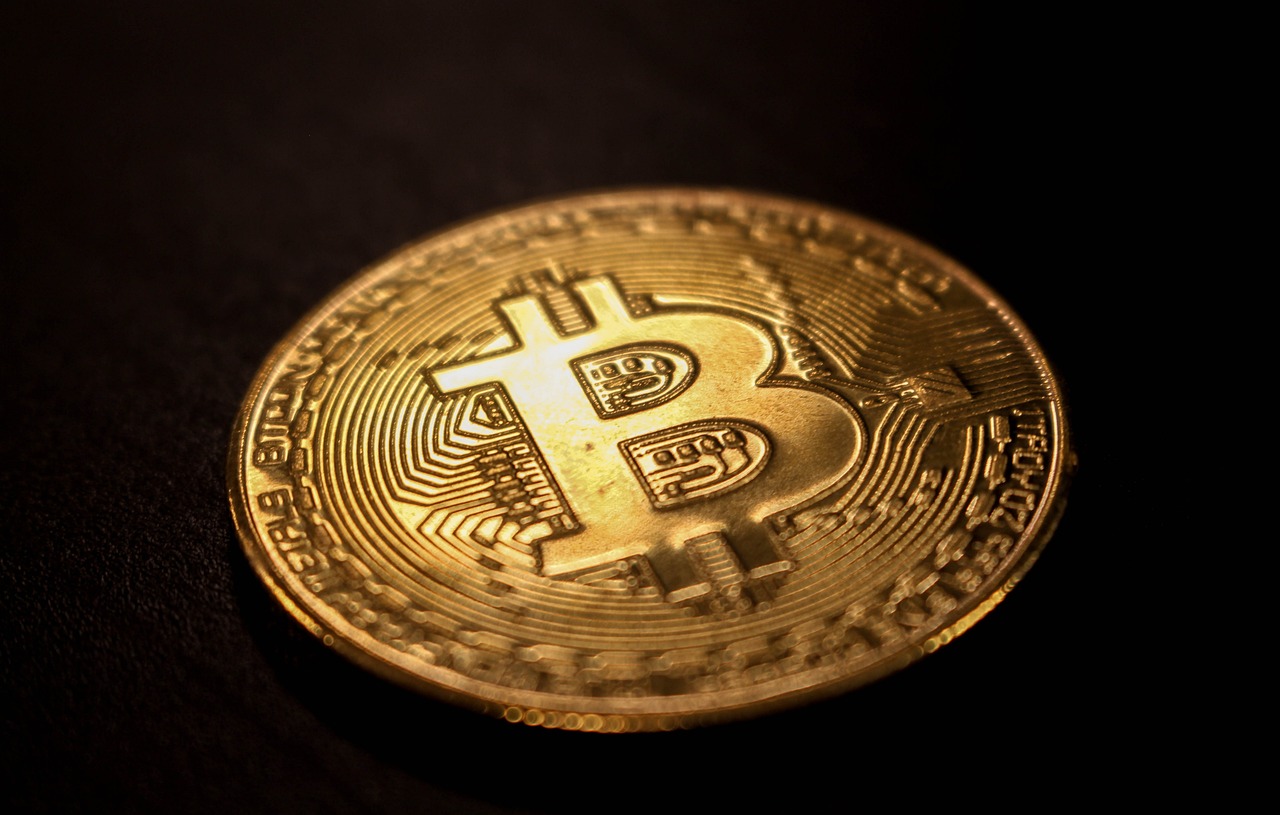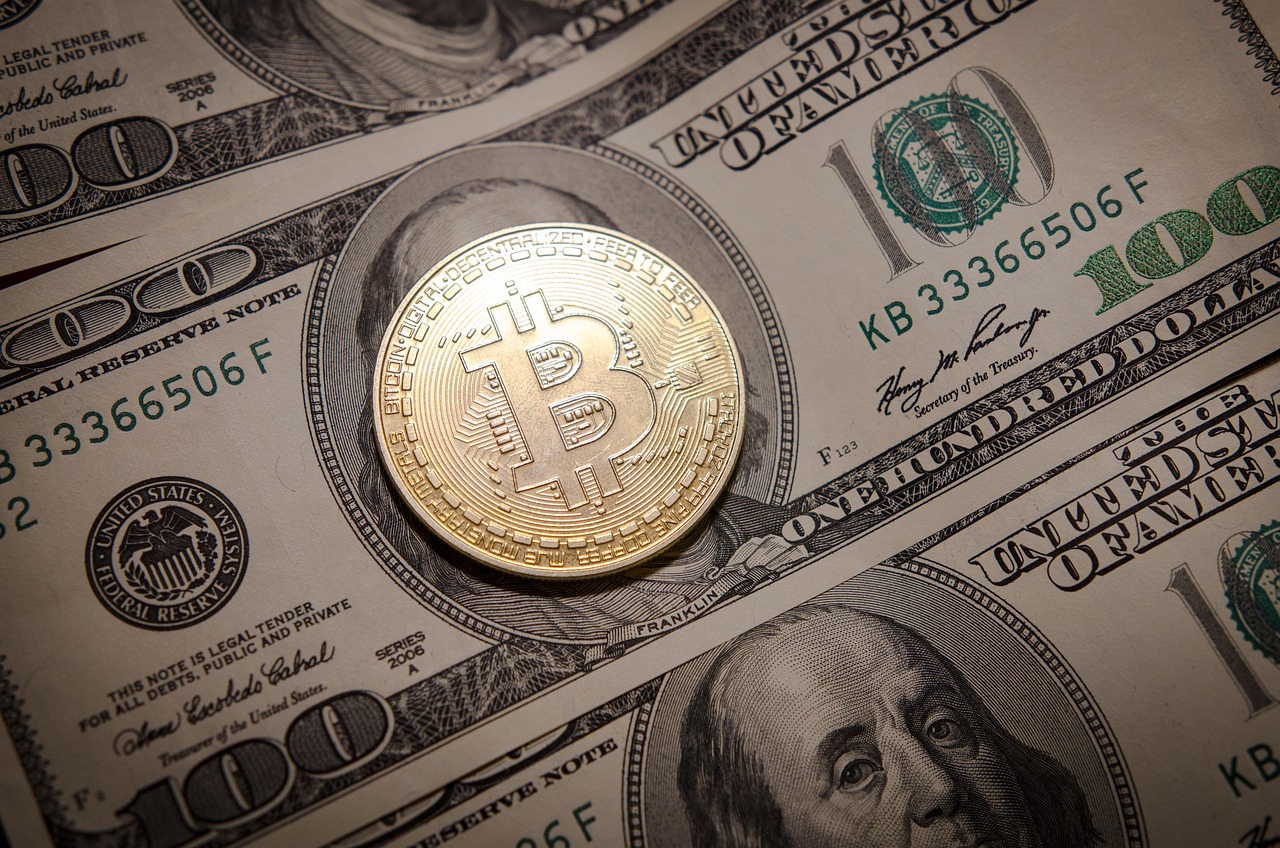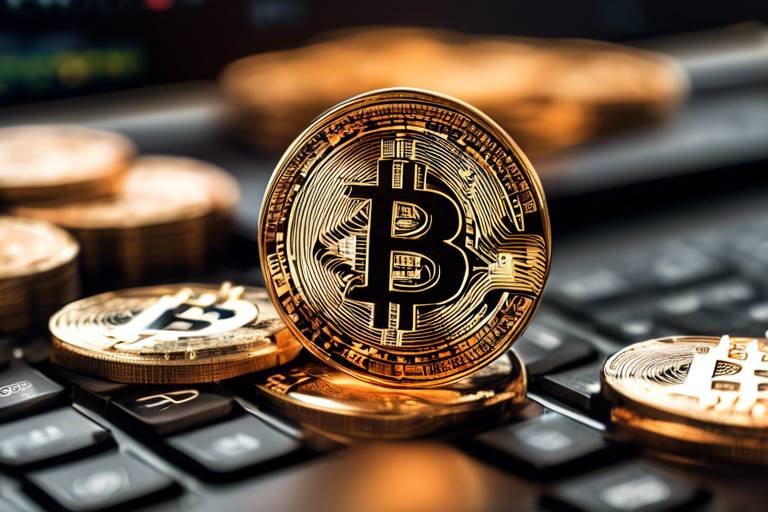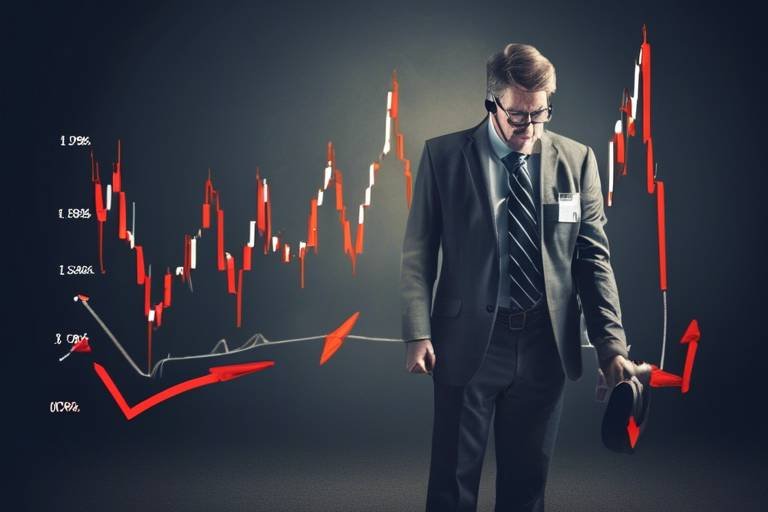Analyzing the Impact of Global Events on Crypto Prices
In today's fast-paced digital world, the cryptocurrency market has emerged as a fascinating space where fortunes can be made or lost in the blink of an eye. But what exactly drives these price fluctuations? The answer lies in a complex interplay of global events that can send ripples through the market. Whether it's a sudden economic downturn, a political crisis, or a technological breakthrough, each event can have profound implications for crypto values. In this article, we will explore how economic, political, and social factors shape the cryptocurrency landscape, influencing investor behavior and market dynamics.
Understanding the impact of global events on crypto prices is akin to navigating a vast ocean; there are calm waters, but also stormy seas that can change the course of your journey. Just as a sailor must be attuned to the weather, investors must keep an eye on global happenings. So, what are these events that can sway the market? Let's dive deeper into the factors at play.
Economic indicators such as inflation rates, unemployment, and GDP growth significantly impact cryptocurrency prices. When traditional markets face turbulence, many investors turn to cryptocurrencies as a hedge against economic instability. For instance, during periods of high inflation, the value of fiat currency diminishes, leading investors to seek refuge in digital assets. Understanding these metrics helps investors gauge market sentiment and make informed decisions in response to economic changes.
To illustrate this, consider the following table that summarizes key economic indicators and their potential effects on crypto prices:
| Economic Indicator | Effect on Crypto Prices |
|---|---|
| High Inflation | Increased demand for cryptocurrencies as a store of value |
| Rising Unemployment | Investor uncertainty may lead to market volatility |
| Positive GDP Growth | Increased investor confidence, potentially driving prices up |
As we can see, economic indicators play a pivotal role in shaping investor sentiment and, consequently, cryptocurrency valuations.
Political events, including elections, policy changes, and geopolitical tensions, can create uncertainty in financial markets. For example, a sudden change in government policy regarding cryptocurrency regulation can lead to immediate shifts in market confidence. When investors perceive instability, they may react by pulling out their investments or seeking safer alternatives, causing a ripple effect on crypto prices.
For instance, the announcement of a new regulation in a major economy can lead to a sell-off in the crypto market, as investors rush to minimize their risks. On the other hand, positive political developments, such as favorable legislation, can spark enthusiasm and drive prices higher. It's a constant dance between fear and greed, where political events can tip the scales in either direction.
The rapid development of blockchain technology and its adoption across various industries can drive crypto prices significantly. When new technologies emerge, they often lead to increased interest and investment in cryptocurrencies. For example, innovations like smart contracts and decentralized finance (DeFi) have opened up new avenues for investment, attracting a broader audience to the crypto space.
Furthermore, as more businesses begin to accept cryptocurrencies as a form of payment, the demand for these digital assets may surge, leading to price increases. The relationship between technology and market growth is undeniable; every breakthrough has the potential to reshape the landscape and influence investor behavior.
Regulatory frameworks surrounding cryptocurrencies are constantly evolving. With governments worldwide grappling with how to manage this new asset class, changes in legislation can have significant repercussions. For instance, stricter compliance requirements may deter some investors, while clear regulatory guidelines can enhance market stability.
It's crucial for investors to stay informed about regulatory developments, as these changes can create both opportunities and challenges in the crypto market. Understanding the legal landscape can help investors navigate the complexities of compliance and make strategic decisions.
Public perception and sentiment play a crucial role in cryptocurrency price movements. Social media trends and influencer opinions can sway investor decisions and market trends. A single tweet from a prominent figure can send prices soaring or crashing. This phenomenon underscores the importance of market sentiment in the crypto world.
The emotional reactions of investors can lead to FOMO (fear of missing out) or FUD (fear, uncertainty, and doubt), creating volatility in the market. Understanding these psychological factors is essential for navigating the often unpredictable waters of cryptocurrency investment.
Analyzing specific global economic events, such as financial crises or pandemics, provides insights into their direct effects on cryptocurrency prices. For example, during the COVID-19 pandemic, many investors flocked to cryptocurrencies as traditional markets faced unprecedented challenges. This case study highlights key moments and their market repercussions, showcasing how external factors can reshape investor behavior and market dynamics.
Understanding investor psychology is essential for grasping market fluctuations. Behavioral finance principles explain how emotions and cognitive biases influence trading decisions in the crypto market. Investors often make decisions based on feelings rather than rational analysis, leading to market anomalies. Recognizing these patterns can help investors avoid common pitfalls and make more informed choices.
This section compares the behavior of cryptocurrencies with traditional financial markets during global events. By examining correlations, investors can better understand the unique characteristics of crypto assets in response to external factors. The differences in volatility, liquidity, and investor behavior between these markets can provide valuable insights for strategic decision-making.
Looking ahead, potential future trends in the cryptocurrency market will likely be influenced by ongoing global events. Insights and predictions can help investors navigate the evolving landscape and make strategic decisions. As we witness rapid technological advancements and changing regulatory environments, staying informed will be key to thriving in the crypto space.
- How do global events affect cryptocurrency prices? Global events can create uncertainty, influence market sentiment, and lead to shifts in investor behavior, impacting cryptocurrency valuations.
- What role do economic indicators play in crypto trading? Economic indicators provide insights into market sentiment, helping investors make informed decisions based on economic changes.
- Can social media really influence crypto prices? Absolutely! Social media trends and influencer opinions can sway investor decisions, leading to significant price movements.

The Role of Economic Indicators
When it comes to investing in cryptocurrencies, understanding the role of economic indicators is crucial. These indicators serve as the pulse of the economy, revealing the health and direction of financial markets. Think of economic indicators as the weather forecast for investors; just as you wouldn’t head out without checking if it’s going to rain, you shouldn’t dive into crypto trading without considering these metrics. Key indicators such as inflation rates, unemployment figures, and GDP growth can significantly sway market sentiment and investor behavior.
For instance, when inflation rates rise, traditional investors often flock to alternative assets like cryptocurrencies to safeguard their wealth. This is because cryptocurrencies are perceived as a hedge against inflation, much like gold. As more investors turn their attention to crypto during inflationary periods, we often see a corresponding spike in prices. Conversely, when unemployment rates are high, consumer spending tends to decrease, leading to bearish market sentiments. This can result in a downturn in crypto prices as investors become more risk-averse.
Moreover, GDP growth is another indicator that can’t be overlooked. A robust GDP growth rate often signals a thriving economy, which can lead to increased investor confidence across all asset classes, including cryptocurrencies. When people feel secure about their financial future, they are more likely to invest in riskier assets, pushing crypto prices higher.
| Economic Indicator | Impact on Crypto Prices |
|---|---|
| Inflation Rates | Higher rates can lead to increased investment in cryptocurrencies as a hedge. |
| Unemployment Rates | Higher unemployment can result in decreased consumer spending, negatively impacting prices. |
| GDP Growth | Strong growth often boosts investor confidence, leading to increased crypto investments. |
It’s important to note that these indicators do not operate in isolation. They are interconnected and can influence one another. For example, rising inflation can lead to increased unemployment, creating a complex web of economic factors that investors must navigate. Understanding these dynamics can empower investors to make more informed decisions, allowing them to anticipate market movements and adjust their strategies accordingly.
In conclusion, keeping an eye on economic indicators is not just a good practice; it's essential for anyone looking to thrive in the volatile world of cryptocurrencies. By understanding how these indicators influence market sentiment and investor behavior, you can position yourself to take advantage of opportunities and mitigate risks in this ever-evolving landscape.
- What are economic indicators? Economic indicators are statistical measures that reflect the economic performance of a country, such as inflation rates, unemployment, and GDP growth.
- How do economic indicators affect cryptocurrency prices? Economic indicators can influence investor sentiment, leading to increased or decreased investment in cryptocurrencies based on the perceived economic health.
- Can I predict crypto prices based on economic indicators? While economic indicators can provide insights into market trends, they cannot guarantee specific price movements due to the volatile nature of cryptocurrencies.

Political Instability and Market Reactions
Political instability can be a double-edged sword in the world of finance, especially in the realm of cryptocurrencies. When we think about how elections, policy changes, or geopolitical tensions can send shockwaves through the markets, it’s essential to recognize that cryptocurrencies are not immune to these fluctuations. In fact, they often react more dramatically than traditional assets. Why is that? Well, the crypto market is still relatively young and tends to be more volatile, making it susceptible to external shocks.
For instance, consider a scenario where a country is facing an election that could potentially lead to significant policy changes. Investors may start to feel uneasy about the future, prompting them to pull out of traditional investments. But what do they do with their money? Many turn to cryptocurrencies as a hedge against uncertainty. This phenomenon can create a surge in demand, driving prices up, or conversely, if the political climate appears too unstable, it could lead to a mass sell-off. This reaction is often fueled by fear and speculation, which are potent motivators in the crypto space.
Additionally, let’s not forget the role of news cycles in shaping market reactions. In today’s digital age, information spreads like wildfire, and social media plays a critical role in how investors perceive political events. A tweet from a prominent figure or a breaking news story can lead to immediate price movements. For example, when a country announces new regulations or sanctions, the crypto market may react almost instantaneously, reflecting the collective sentiment of investors. This rapid response can create a feedback loop, where initial reactions prompt further buying or selling, amplifying the price changes.
To illustrate this further, let’s take a look at a table that outlines some notable instances of political instability and their immediate effects on cryptocurrency prices:
| Event | Date | Effect on Bitcoin Price |
|---|---|---|
| Brexit Vote | June 23, 2016 | Increased by 10% in the following week |
| US Presidential Election | November 8, 2016 | Surged by 20% post-election |
| COVID-19 Pandemic Declaration | March 11, 2020 | Dropped 50% in a week, then recovered |
| Russia-Ukraine Conflict | February 24, 2022 | Increased by 15% within days |
As we can see, the interplay between political events and cryptocurrency prices can be profound. Investors must stay informed and be ready to adapt to the ever-changing landscape of global politics. The key takeaway here is that while cryptocurrencies may offer a refuge during times of political unrest, they are also subject to the whims of market sentiment influenced by these very events. Understanding this relationship is crucial for anyone looking to navigate the crypto waters successfully.
- How does political instability affect cryptocurrency prices? Political instability can lead to increased volatility in crypto prices as investors react to uncertainty and potential regulatory changes.
- Can cryptocurrencies be a safe haven during political turmoil? Yes, many investors turn to cryptocurrencies as a hedge against uncertainty in traditional markets, but this can also lead to significant price swings.
- What role does social media play in cryptocurrency market reactions? Social media can amplify investor sentiment, leading to rapid price changes based on news and public perception.
- Are cryptocurrencies more volatile than traditional assets? Generally, yes. Cryptocurrencies tend to be more volatile due to their relatively small market size and the influence of speculative trading.

Technological Advancements and Adoption
In the fast-paced world of cryptocurrency, technological advancements play a pivotal role in shaping market dynamics and influencing investor sentiment. With each breakthrough, the crypto landscape evolves, often leading to significant price fluctuations. Think of blockchain technology as the engine that drives this digital revolution. Just like how the invention of the internet transformed communication, blockchain is revolutionizing how we think about finance, ownership, and trust.
One of the most exciting developments in this space is the rise of Decentralized Finance (DeFi). DeFi platforms are built on blockchain technology and aim to recreate traditional financial systems—like lending and borrowing—without intermediaries. This innovation not only enhances accessibility for users but also introduces new investment opportunities. Imagine being able to earn interest on your crypto holdings without going through a bank; that’s the power of DeFi!
Moreover, the integration of smart contracts has opened up a world of possibilities. These self-executing contracts with the terms of the agreement directly written into code allow for trustless transactions. For instance, if you’re buying a house, a smart contract can automatically transfer ownership once payment is confirmed, eliminating the need for complex paperwork and intermediaries. It’s like having a digital notary that works 24/7!
Another significant trend is the increasing adoption of cryptocurrencies by mainstream companies. Giants like PayPal and Tesla have started accepting cryptocurrencies, signaling a shift in how we perceive digital currencies. As more businesses embrace crypto, it not only legitimizes the market but also encourages everyday users to jump on the bandwagon. This growing acceptance is akin to the early days of credit cards; once people started using them, it became a staple in everyday transactions.
However, it’s not just about adoption by businesses; individual users are also becoming more tech-savvy. The rise of user-friendly wallets and exchanges has made it easier than ever for people to buy, sell, and store cryptocurrencies. This democratization of access is crucial for the growth of the market. As more people become comfortable with the technology, we can expect to see an influx of new investors, further driving demand and, consequently, prices.
Let’s not forget about the role of scalability solutions. Innovations like the Lightning Network for Bitcoin and Ethereum 2.0 are designed to enhance transaction speeds and reduce costs. These advancements are vital for handling the increasing volume of transactions as more people and businesses adopt cryptocurrencies. Just like upgrading a highway to accommodate more traffic, these solutions ensure that the crypto infrastructure can support future growth.
In conclusion, technological advancements and their adoption are at the heart of the cryptocurrency market’s evolution. As new technologies emerge and gain traction, they not only influence investor behavior but also redefine the very nature of money and finance. Staying informed about these trends is essential for anyone looking to navigate the crypto landscape effectively.
- What are the key technological advancements in the crypto space? - Key advancements include DeFi, smart contracts, and scalability solutions.
- How does DeFi impact traditional finance? - DeFi aims to recreate financial systems without intermediaries, enhancing accessibility and investment opportunities.
- Why is cryptocurrency adoption by mainstream companies important? - It legitimizes the market and encourages everyday users to invest in cryptocurrencies.
- What is the significance of scalability solutions? - They enhance transaction speeds and reduce costs, supporting the growing volume of crypto transactions.

Regulatory Changes and Compliance
The world of cryptocurrency is like a roller coaster, full of exhilarating highs and nerve-wracking lows, largely influenced by the regulatory landscape. As governments and financial authorities around the globe grapple with the implications of digital currencies, the rules governing their use and trade are constantly shifting. This creates an environment where both opportunity and risk coexist, making it crucial for investors to stay informed about regulatory changes. For instance, when a country tightens its regulations on crypto trading, panic can set in, leading to a swift decline in prices. Conversely, positive regulatory developments can send prices soaring as confidence is restored.
One of the most significant aspects of regulatory changes is their impact on compliance requirements for cryptocurrency exchanges and businesses. These regulations often dictate how cryptocurrencies can be traded, how businesses must report their earnings, and what measures they must take to prevent fraud and money laundering. As a result, companies that fail to comply with these regulations may face severe penalties, including hefty fines or even shutdown. This creates a ripple effect in the market, as investors may become wary of platforms that are not compliant, fearing their investments could be at risk.
Moreover, the regulatory environment varies dramatically from one country to another. In regions like Europe and North America, regulatory bodies are beginning to establish clearer frameworks for cryptocurrencies, which can be seen as a double-edged sword. On one hand, clear regulations can foster trust and encourage more institutional investment, leading to greater market stability. On the other hand, overly stringent regulations can stifle innovation and drive businesses to operate in less regulated jurisdictions, which can create a fragmented market. For example, countries like China have taken a hard stance against cryptocurrencies, leading many crypto companies to relocate to friendlier environments.
To illustrate the impact of regulatory changes, consider the following table that summarizes recent significant regulatory events and their effects on cryptocurrency prices:
| Date | Event | Country | Price Impact |
|---|---|---|---|
| September 2021 | China bans crypto transactions | China | Price dropped by 10% |
| March 2022 | EU proposes comprehensive crypto regulation | European Union | Price surged by 15% |
| July 2022 | SEC clarifies stance on crypto securities | United States | Price increased by 20% |
Additionally, compliance with regulations is not just about avoiding penalties; it also influences the broader market sentiment. Investors are more likely to engage with cryptocurrencies that are backed by compliant exchanges, as it reduces the perceived risks associated with fraud and volatility. As the market matures, the expectation is that more cryptocurrencies will adhere to regulatory standards, which could lead to a more stable and trustworthy market environment.
In conclusion, understanding the intricate relationship between regulatory changes and compliance is essential for anyone involved in the cryptocurrency market. As regulations evolve, they will continue to shape investor behavior and market dynamics, making it vital for individuals and businesses alike to stay informed and adaptable in this ever-changing landscape.
- What are the main regulatory bodies overseeing cryptocurrencies?
Regulatory bodies vary by country, but key players include the SEC in the United States, the FCA in the UK, and ESMA in the European Union.
- How do regulatory changes affect cryptocurrency prices?
Regulatory changes can lead to increased investor confidence or panic, impacting market prices significantly.
- What should investors look for in compliant exchanges?
Investors should look for exchanges that are registered with regulatory bodies, have transparent policies, and adhere to anti-money laundering regulations.

Market Sentiment and Social Media Influence
The world of cryptocurrency is not just driven by numbers and algorithms; it’s also significantly shaped by market sentiment and the pervasive influence of social media. Imagine walking into a crowded room where everyone is buzzing about the latest trends—this is akin to the atmosphere in the crypto market, where emotions and perceptions can swing prices dramatically in mere moments. Whether it's a tweet from a prominent figure or a viral meme, the ripple effects can be profound, often leading to rapid price fluctuations.
Social media platforms like Twitter, Reddit, and Telegram have become the modern-day town squares for crypto enthusiasts and investors. Here, opinions are shared, news is disseminated, and trends can emerge overnight. For instance, a single tweet from a celebrity or a well-known crypto influencer can send a coin soaring or plummeting. This phenomenon is often referred to as the “Elon Musk Effect,” where Musk's tweets about Dogecoin or Bitcoin have led to immediate and significant shifts in market valuations.
Moreover, the concept of FOMO (Fear of Missing Out) plays a critical role in shaping market sentiment. When investors see others profiting from a particular cryptocurrency, they may rush to buy in, driving the price even higher. Conversely, news of a potential downturn or negative sentiment can lead to panic selling, further exacerbating the price drop. This interplay between social media and market sentiment creates a volatile environment where prices can swing wildly based on collective emotions rather than intrinsic value.
To illustrate the impact of social media on market sentiment, consider the following table that highlights key events and their corresponding price movements:
| Event | Date | Price Movement |
|---|---|---|
| Elon Musk tweets about Dogecoin | April 2021 | Price surged by 20% |
| Negative news about Bitcoin regulation | May 2021 | Price dropped by 30% |
| Reddit group promotes a lesser-known altcoin | February 2021 | Price increased by 300% |
This table exemplifies how social media dynamics can lead to swift and sometimes unpredictable changes in cryptocurrency prices. Investors need to be aware that while social media can provide valuable insights, it can also be a double-edged sword. The rapid spread of information can lead to herd behavior, where individuals make decisions based on the actions of others rather than their own analyses.
In conclusion, the influence of market sentiment and social media on cryptocurrency prices cannot be overstated. As we continue to navigate this digital frontier, investors must remain vigilant, discerning between genuine insights and the noise that often permeates the online space. By understanding the emotional and psychological triggers that drive market sentiment, investors can make more informed decisions, ultimately leading to more successful trading strategies.
- How does social media impact cryptocurrency prices? Social media can amplify market sentiment, leading to rapid price changes based on collective emotions and opinions shared by influencers and the community.
- What is FOMO in the context of cryptocurrency? FOMO, or Fear of Missing Out, refers to the anxiety investors feel when they see others profiting from a cryptocurrency, prompting them to buy in without thorough analysis.
- Can a single tweet really affect crypto prices? Yes, a single tweet from a high-profile individual can lead to significant price movements, demonstrating the power of social media in the crypto space.

Global Economic Events: A Case Study
The relationship between global economic events and cryptocurrency prices is a fascinating subject that often leaves investors scratching their heads. Just think about it: when a financial crisis hits, or a pandemic sweeps across nations, how do these occurrences ripple through the crypto market? To illustrate this, let's take a closer look at two significant events: the 2008 financial crisis and the COVID-19 pandemic. Both events not only shook the foundations of traditional financial markets but also had profound effects on the cryptocurrency landscape.
During the 2008 financial crisis, we witnessed a massive loss of trust in traditional banking systems. As people scrambled to secure their assets, many turned to alternative investments like cryptocurrencies. Bitcoin, which was just emerging at the time, saw its value soar as it was perceived as a safe haven against the failing financial institutions. In fact, Bitcoin's price increased from around $0.06 in July 2010 to nearly $1,000 by late 2013. This dramatic increase was a clear reflection of the growing interest in decentralized finance during a time of economic uncertainty.
Fast forward to 2020, and the COVID-19 pandemic created a different kind of chaos. As governments around the world implemented lockdowns and stimulus packages, the financial markets reacted with volatility. In March 2020, Bitcoin's value plummeted from approximately $9,100 to around $4,700 in a matter of days, mirroring the panic in traditional markets. However, as the dust settled and governments began to print money at unprecedented rates, Bitcoin and other cryptocurrencies rebounded spectacularly. By the end of 2020, Bitcoin had surged to over $29,000, driven by a combination of institutional investment and retail interest.
To better understand the impact of these global economic events, let’s break down some key statistics:
| Event | Initial Impact on Bitcoin Price | Recovery Time | Peak Price Post-Event |
|---|---|---|---|
| 2008 Financial Crisis | Increased from $0.06 to $1,000 (2013) | Approximately 3 years | $1,000 |
| COVID-19 Pandemic | Dropped to $4,700 | Less than 1 year | $29,000 |
This case study highlights a crucial point: investors often turn to cryptocurrencies during times of economic turmoil, seeking refuge from the instability of traditional financial systems. The emotional response to these global events—fear, uncertainty, and the desire for security—drives individuals to explore alternative assets. As we analyze these fluctuations, it’s important to recognize how investor sentiment can create a self-fulfilling prophecy in the crypto market.
As we look to the future, the implications of these economic events will continue to shape the cryptocurrency landscape. With the rise of decentralized finance (DeFi) and the increasing acceptance of cryptocurrencies by mainstream financial institutions, it’s clear that global events will continue to play a pivotal role in determining the trajectory of crypto prices. Understanding these dynamics not only helps investors navigate the market but also prepares them for the potential surprises that lie ahead.
- How do global economic events typically affect cryptocurrency prices? Global economic events can create uncertainty, leading investors to seek alternative assets like cryptocurrencies, which can cause price fluctuations.
- What was the impact of the 2008 financial crisis on Bitcoin? The 2008 financial crisis led to a significant increase in Bitcoin's value as it was seen as a safe haven against failing banks.
- How did the COVID-19 pandemic influence the crypto market? The pandemic initially caused a sharp decline in Bitcoin's price, but it later surged dramatically as investors sought refuge in cryptocurrencies amidst economic instability.

Investor Psychology and Behavioral Finance
When it comes to the world of cryptocurrencies, understanding investor psychology is like holding a treasure map. It reveals the hidden motivations, fears, and biases that drive market behavior. In a space as volatile as crypto, where prices can skyrocket or plummet in the blink of an eye, the emotional state of investors plays a pivotal role. Have you ever noticed how a single tweet from a prominent figure can send Bitcoin's price soaring? That's the power of psychology at work!
Behavioral finance, a fascinating field that merges psychology with traditional finance, helps us understand why investors often act irrationally. Unlike traditional finance, which assumes that all investors are rational and make decisions purely based on logic, behavioral finance acknowledges that emotions can cloud judgment. For instance, during a market rally, investors may experience a sense of euphoria, leading them to overlook potential risks. Conversely, during a downturn, panic can set in, prompting hasty decisions that may not align with long-term goals.
Several cognitive biases affect investor behavior in the crypto market. Here are a few key ones:
- Herding Behavior: This is when investors follow the crowd, buying or selling based on what others are doing rather than their own analysis. It can lead to bubbles or crashes.
- Loss Aversion: Investors tend to feel the pain of losses more acutely than the pleasure of gains. This can result in holding onto losing investments for too long, hoping for a rebound.
- Overconfidence: Many investors overestimate their knowledge and ability to predict market movements, often leading to risky investment choices.
These biases not only affect individual traders but can also create larger market trends. When a significant number of investors react similarly to news or events, it can amplify price movements, creating a self-fulfilling prophecy. For example, if a major regulatory announcement is perceived negatively, the collective fear can trigger a sell-off, regardless of the actual implications of the news.
Moreover, the rise of social media has added another layer to this psychological landscape. Platforms like Twitter and Reddit have become hotbeds for information and speculation, where trends can shift rapidly based on viral content. The FOMO (Fear of Missing Out) phenomenon is particularly pronounced in the crypto community, with investors rushing to buy into coins that are trending, often without adequate research. This behavior can lead to inflated prices and subsequent crashes, as seen in various crypto bubbles.
Understanding these psychological factors is crucial for anyone looking to navigate the turbulent waters of cryptocurrency investment. By recognizing the emotional drivers behind their decisions, investors can develop strategies to mitigate risks and make more informed choices. It’s about finding that balance between emotion and logic, much like a tightrope walker carefully navigating their path.
In conclusion, investor psychology and behavioral finance are integral components of the cryptocurrency landscape. By acknowledging the emotional undercurrents that influence trading decisions, investors can better position themselves to weather market fluctuations and seize opportunities as they arise.
- What is behavioral finance? Behavioral finance is a field that studies how psychological factors affect financial decision-making.
- How does investor psychology impact cryptocurrency prices? Investor psychology can lead to irrational decisions that amplify market trends, affecting prices significantly.
- What are common cognitive biases in investing? Common biases include herding behavior, loss aversion, and overconfidence, all of which can skew decision-making.
- How can investors manage psychological risks? Investors can manage these risks by developing a disciplined investment strategy, conducting thorough research, and being mindful of emotional triggers.

Comparative Analysis with Traditional Markets
When we dive into the world of cryptocurrency, it's hard not to notice the stark differences between it and traditional financial markets. Think of cryptocurrencies as the rebellious teenager in the family of finance—volatile, unpredictable, and always pushing boundaries. In contrast, traditional markets are like the responsible adult, often stable and guided by established rules and regulations. But how do these two realms interact during global events? Let's break it down.
During times of economic uncertainty, such as a financial crisis or a global pandemic, both cryptocurrencies and traditional assets like stocks and bonds respond, but often in contrasting ways. For instance, during the COVID-19 pandemic, many traditional markets saw significant downturns, while Bitcoin and other cryptocurrencies experienced a surge in interest and investment. This divergence can be attributed to several factors:
- Market Maturity: Traditional markets have a longer history and are influenced by decades of economic data, while cryptocurrencies are relatively new and often react more dramatically to news and events.
- Investor Behavior: The psychology of investors in both markets differs. Traditional investors tend to be more risk-averse, while crypto investors often embrace volatility, viewing it as an opportunity for higher returns.
- Liquidity: Cryptocurrencies can be traded 24/7, providing more opportunities for quick trades, whereas traditional markets have set hours, which can limit trading flexibility.
To illustrate these points, let’s take a look at a comparative analysis of market responses to a recent global event: the U.S. Federal Reserve's interest rate hikes. In traditional markets, such announcements typically lead to a cautious approach from investors, resulting in sell-offs in stocks and bonds. Conversely, the crypto market often reacts with a mix of excitement and skepticism, as some investors view these hikes as a signal to invest in alternative assets like Bitcoin to hedge against inflation.
| Event | Traditional Market Reaction | Cryptocurrency Reaction |
|---|---|---|
| COVID-19 Pandemic | Sharp decline in stock prices | Initial drop followed by significant rally |
| U.S. Interest Rate Hikes | Sell-off in stocks and bonds | Mixed reactions, with some cryptocurrencies rising |
| Geopolitical Tensions | Increased volatility in traditional assets | Spike in crypto trading volume |
As we can see, the responses of these markets can vary widely based on the nature of the event. In recent years, the correlation between crypto and traditional markets has been a topic of heated debate among investors. Some argue that cryptocurrencies are becoming more integrated into the global financial system, while others maintain that they remain largely independent. This ongoing discussion highlights the need for investors to stay informed about both market dynamics.
Ultimately, understanding the comparative analysis between cryptocurrencies and traditional markets is crucial for making informed investment decisions. While cryptocurrencies may offer the allure of high returns, they also come with significant risks, especially during turbulent times. Traditional markets, while generally more stable, can also present challenges, particularly in a rapidly changing economic landscape. As an investor, it's essential to weigh the pros and cons of each and consider how global events might sway your strategy.
- What are the main differences between cryptocurrencies and traditional assets? Cryptocurrencies are typically more volatile and less regulated than traditional assets, which have established markets and historical data.
- How do global events affect cryptocurrency prices? Global events can lead to increased volatility in crypto markets, often causing rapid price fluctuations based on investor sentiment.
- Should I invest in cryptocurrencies or traditional markets? It depends on your risk tolerance and investment goals. Diversifying between both can help mitigate risks.

Future Trends and Predictions
The cryptocurrency landscape is constantly evolving, shaped by a myriad of factors that include technological advancements, regulatory changes, and shifting market dynamics. As we look ahead, several key trends are emerging that could significantly influence the future of cryptocurrencies. One of the most notable trends is the increasing institutional adoption of digital assets. Large financial institutions and corporations are beginning to recognize the potential of cryptocurrencies, not just as speculative investments, but as viable assets for diversification and hedging against inflation. This trend could lead to greater legitimacy for cryptocurrencies and potentially stabilize their prices in the long run.
Another trend to watch is the rise of decentralized finance (DeFi). DeFi platforms are revolutionizing the way individuals interact with financial services by removing intermediaries and enabling peer-to-peer transactions. As more users become aware of and engage with these platforms, we may see a surge in demand for cryptocurrencies that power DeFi applications. This could lead to increased price volatility as new players enter the market, seeking to capitalize on the opportunities presented by DeFi.
Moreover, the integration of blockchain technology into various sectors, such as supply chain management, healthcare, and finance, is expected to drive further interest in cryptocurrencies. As businesses recognize the efficiency and transparency that blockchain provides, we could see a spike in demand for cryptocurrencies that facilitate these transactions. This integration not only enhances the utility of cryptocurrencies but also promotes broader acceptance among the general public.
On the regulatory front, the ongoing evolution of cryptocurrency regulations worldwide will play a crucial role in shaping the market's future. As governments and regulatory bodies develop clearer frameworks for the use and trading of cryptocurrencies, investor confidence may increase. However, it's important to note that overly stringent regulations could stifle innovation and limit market growth. Thus, the balance between regulation and innovation will be a critical factor to monitor.
Finally, market sentiment remains a powerful driver of cryptocurrency prices. The influence of social media, news cycles, and public perception cannot be underestimated. As more retail investors enter the market, their collective sentiment could lead to rapid price fluctuations. Understanding this psychology will be vital for anyone looking to navigate the crypto space successfully.
In summary, the future of cryptocurrencies is poised for exciting developments. With increasing institutional adoption, the rise of DeFi, broader blockchain integration, evolving regulations, and the powerful influence of market sentiment, investors must stay informed and agile. As we venture into this uncharted territory, the potential for both opportunity and risk is immense.
- What is driving the future of cryptocurrency? The future of cryptocurrency is driven by institutional adoption, technological advancements, regulatory developments, and market sentiment.
- How will DeFi impact cryptocurrency prices? As DeFi platforms gain popularity, demand for cryptocurrencies that facilitate these services may increase, leading to potential price volatility.
- What role do regulations play in the crypto market? Clear regulations can enhance investor confidence, while overly strict regulations may hinder market growth.
- Why is market sentiment important? Market sentiment influences trading behavior and can lead to rapid price changes, making it essential for investors to understand.
Frequently Asked Questions
- How do global economic indicators affect cryptocurrency prices?
Global economic indicators such as inflation rates, employment statistics, and GDP growth can significantly influence cryptocurrency prices. When these indicators show positive trends, investor confidence typically rises, leading to increased demand and higher prices for cryptocurrencies. Conversely, negative indicators can trigger fear and uncertainty, resulting in price declines.
- What role does political instability play in cryptocurrency valuation?
Political instability, including elections, policy shifts, and geopolitical tensions, can create a ripple effect in financial markets, including cryptocurrencies. Investors often react to uncertainty by pulling back on investments, which can lead to price drops. On the flip side, stability and favorable political environments can boost investor confidence and drive prices up.
- How does technological advancement impact the crypto market?
The rapid pace of technological advancements, particularly in blockchain technology, plays a crucial role in the growth of the cryptocurrency market. Innovations can enhance security, scalability, and usability, attracting more investors and driving prices higher. The adoption of cryptocurrencies by mainstream industries further fuels this growth.
- What are the effects of regulatory changes on cryptocurrency?
Regulatory changes can have dramatic effects on cryptocurrency markets. New regulations may either legitimize cryptocurrencies, increasing investor confidence, or impose restrictions that can stifle growth. Staying informed about legislative developments is vital for investors, as these changes can directly impact market dynamics.
- How does social media influence cryptocurrency prices?
Social media plays a significant role in shaping public perception and sentiment around cryptocurrencies. Viral trends and influencer endorsements can lead to rapid price movements, as investors react to the latest news or opinions. This can create a bandwagon effect, where the fear of missing out (FOMO) drives prices up or down.
- Can you provide an example of a global event that affected crypto prices?
One notable example is the COVID-19 pandemic, which caused significant fluctuations in financial markets, including cryptocurrencies. Initially, prices dropped sharply as investors panicked, but they later rebounded as people sought alternative investments and digital currencies gained popularity during lockdowns.
- What is the significance of investor psychology in crypto trading?
Investor psychology is crucial in understanding market fluctuations. Emotions such as fear and greed can drive trading decisions, often leading to irrational behavior. Cognitive biases, like overconfidence, can also affect how investors perceive risks and opportunities in the crypto market.
- How do cryptocurrencies compare to traditional markets during global events?
Cryptocurrencies often behave differently than traditional financial markets during global events. For instance, while stock markets may react negatively to economic downturns, cryptocurrencies can sometimes thrive as investors look for alternative assets. Analyzing these correlations helps investors understand the unique dynamics of crypto assets.
- What future trends should investors watch in the crypto market?
Investors should keep an eye on trends such as increased institutional adoption, advancements in blockchain technology, and evolving regulatory landscapes. These factors will likely shape the future of the cryptocurrency market and influence investment strategies.



















